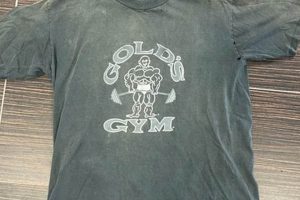This specific type of watch accessory, often found on timepieces from past eras, combines the inherent value and aesthetic appeal of a precious metal with the functional purpose of securing a watch to the wrist. It denotes a band, typically constructed of interconnected links, fashioned from a gold alloy and exhibiting characteristics indicative of its age, such as patina, wear patterns, and design elements common to the period in which it was manufactured. Examples include mesh-style bands from the mid-20th century or intricately engraved link designs popular in earlier periods.
Such an item possesses both intrinsic and extrinsic value. The inherent worth derives from the quantity and purity of the gold used in its construction. Extrinsic value stems from factors such as its historical significance, the rarity of its design, its condition, and its provenance (history of ownership). These accessories can enhance the perceived value and collectibility of the timepiece to which they are attached, reflecting the style and craftsmanship of a bygone era and providing a tangible connection to horological history. They are often considered a statement of personal taste and a reflection of the owner’s appreciation for vintage aesthetics.
The subsequent sections will delve into specific considerations for identifying, evaluating, and maintaining these valuable accessories, addressing topics such as assessing gold content, recognizing common design features, and implementing best practices for cleaning and preservation.
Essential Considerations for Vintage Gold Watch Bracelets
Acquiring and maintaining these accessories requires careful attention to detail. The following guidelines offer practical advice for evaluating authenticity, condition, and appropriate care.
Tip 1: Verify Gold Content. Examine the accessory for hallmarks indicating gold purity (e.g., 14K, 18K). Acid testing, performed by a qualified jeweler, offers a more definitive assessment when hallmarks are absent or questionable. Note that plating significantly impacts value.
Tip 2: Assess Link Integrity. Carefully inspect each link for signs of wear, stretching, or damage. Weakened links compromise the bracelet’s structural integrity and increase the risk of breakage. Professional repair may be necessary.
Tip 3: Examine the Clasp Mechanism. Ensure the clasp functions securely and reliably. A faulty clasp presents a significant risk of the watch detaching from the wrist. Consider having a watchmaker service or replace a worn or damaged clasp.
Tip 4: Research Period-Specific Designs. Familiarize yourself with design characteristics prevalent during different eras. This knowledge assists in authenticating the accessory and identifying potential modifications or replacements that may detract from its originality.
Tip 5: Evaluate Patina and Wear. Understand the difference between desirable patina, which adds character, and detrimental wear, which indicates damage. Excessive polishing can remove patina and diminish the piece’s historical appeal.
Tip 6: Consider Professional Cleaning. While gentle cleaning is acceptable, avoid harsh chemicals or abrasive materials. Professional cleaning, performed by a jeweler experienced in vintage pieces, can safely remove dirt and grime without damaging the gold or altering the patina.
Tip 7: Document Provenance When Possible. Any available documentation regarding the bracelet’s history (e.g., original purchase receipts, previous ownership records) enhances its value and collectibility. Maintain these records securely.
Adhering to these guidelines enables informed decisions when acquiring and caring for these valuable accessories, preserving their aesthetic appeal and historical significance.
The subsequent section will address common issues encountered with this item and provide solutions for resolving them.
1. Gold Alloy Purity
The purity of the gold alloy used in the construction of a this piece is a primary determinant of its intrinsic value and significantly impacts its overall characteristics. The term “purity” refers to the proportion of pure gold present within the alloy, typically expressed in karats (K) or as a millesimal fineness (e.g., 750 for 18K gold).
- Hallmarking and Identification
Hallmarks, small stamps or engravings on the metal, indicate the gold purity. Common hallmarks include 14K (58.3% pure gold), 18K (75% pure gold), and 22K (91.6% pure gold). Absence of a hallmark does not necessarily negate authenticity but necessitates professional testing. Understanding these markings allows for initial assessment of the gold content.
- Impact on Color and Hardness
Gold, in its pure form, is a soft and malleable metal. Alloying with other metals such as silver, copper, or zinc increases hardness and alters the color. Lower karat gold alloys (e.g., 10K) typically exhibit a paler yellow hue and greater resistance to scratches compared to higher karat alloys (e.g., 22K), which display a richer yellow color but are more susceptible to damage. The choice of alloy directly affects the bracelet’s durability and aesthetic appearance.
- Corrosion Resistance and Longevity
Gold is highly resistant to corrosion. Higher purity alloys exhibit superior resistance, retaining their luster and structural integrity over extended periods. Lower purity alloys, containing higher proportions of base metals, are more susceptible to tarnishing or corrosion, especially in environments with high humidity or exposure to chemicals. This influences the bracelet’s long-term preservation and maintenance requirements.
- Valuation and Market Price
The market price of a “vintage gold watch bracelet” is directly correlated with its gold content. Accessories crafted from higher karat alloys command higher prices due to the greater quantity of precious metal. However, other factors such as design rarity, historical significance, and overall condition also influence the final valuation. Assessing gold purity is an essential step in determining the fair market value.
The gold alloy purity serves as a cornerstone in evaluating these pieces. It influences not only the items monetary worth but also its physical properties, aesthetic qualities, and long-term durability, directly impacting its appeal to collectors and enthusiasts.
2. Linkage Integrity
Linkage integrity, referring to the structural soundness and connectivity of individual links within a “vintage gold watch bracelet”, directly determines its functionality and lifespan. The interconnected links form the essential chain that secures the watch to the wearer’s wrist. Compromised integrity, resulting from wear, stress, or material fatigue, creates a potential failure point, risking detachment and loss of the timepiece. For example, a bracelet with multiple stretched or weakened links is more prone to breakage under normal daily use compared to one with uniformly sound links. A single fractured link can initiate a cascade of failures, rapidly compromising the entire structure.
The assessment of linkage integrity involves careful visual inspection and, in some cases, tactile examination. Visual clues include visible gaps between links, distortions in the link shape, and evidence of prior repairs. Tactile assessment involves gently flexing the bracelet to identify areas of excessive play or instability. The type of link design also influences its vulnerability. Intricate or delicate link patterns are inherently more susceptible to damage than simpler, more robust designs. Furthermore, the gold alloy composition influences linkage integrity. Higher purity gold, while more valuable, is softer and more prone to deformation under stress. A vintage bracelet crafted from a high-karat gold alloy requires more frequent inspection and careful handling to prevent damage.
Understanding the linkage integrity of a “vintage gold watch bracelet” is paramount for responsible ownership. Regular inspection allows for early detection of potential problems, enabling preventative maintenance before catastrophic failure occurs. Simple interventions, such as tightening loose connections or replacing individual weakened links, can significantly extend the bracelet’s usable life. Moreover, recognizing the inherent limitations of vintage pieces encourages mindful wear and handling practices, preserving both the functionality and aesthetic appeal of this accessory. Failure to prioritize linkage integrity leads to inevitable failure of the bracelet.
3. Clasp Functionality
Clasp functionality serves as a critical determinant of a “vintage gold watch bracelet’s” overall utility and security. The clasp, a mechanism designed to fasten the bracelet around the wearer’s wrist, represents the primary safeguard against accidental loss of the timepiece. A compromised clasp mechanism, whether due to wear, corrosion, or mechanical failure, negates the bracelet’s intended purpose, regardless of the gold’s purity or the aesthetic value of the design. For instance, a vintage watch with a rare and exquisitely crafted gold bracelet loses its practical worth if the clasp fails to secure it reliably, rendering it unwearable in everyday situations. The inverse is also true; a meticulously maintained clasp on an otherwise worn bracelet can preserve the watch’s functionality and prevent potential damage from falls or detachment.
The design and construction of vintage watch clasps vary considerably, reflecting the technological capabilities and stylistic preferences of different eras. Examples include simple friction clasps, fold-over clasps, and intricate box clasps with multiple locking mechanisms. Each design exhibits unique vulnerabilities. Friction clasps, relying solely on pressure to maintain closure, are susceptible to loosening over time, particularly with frequent use. Fold-over clasps, characterized by a hinged design, can suffer from wear at the hinge points, leading to instability. Box clasps, while offering greater security, are more complex and prone to malfunction if dirt or debris accumulates within the mechanism. Understanding the specific design characteristics of a vintage clasp is essential for proper maintenance and timely repair.
In conclusion, clasp functionality forms an indispensable element of a “vintage gold watch bracelet.” Its reliability directly impacts the wearability and preservation of the associated timepiece. Identifying potential clasp issues through regular inspection and addressing them promptly through professional servicing are crucial steps in maintaining the bracelet’s integrity and safeguarding the watch against loss or damage. Prioritizing clasp functionality ultimately ensures that the “vintage gold watch bracelet” continues to fulfill its intended purpose as a secure and aesthetically pleasing component of the watch ensemble.
4. Era-Specific Design
Era-specific design constitutes a defining characteristic of a “vintage gold watch bracelet,” inextricably linking it to a specific historical period and its prevailing aesthetic sensibilities. The design elements, materials, and manufacturing techniques employed in crafting the bracelet serve as a tangible reflection of the socio-cultural context in which it originated. The impact of era-specific design extends beyond mere aesthetics; it significantly influences the bracelet’s value, collectibility, and historical significance. For instance, Art Deco bracelets from the 1920s and 1930s, characterized by geometric patterns and the use of contrasting materials like onyx and diamonds, command premium prices due to their distinctive style and association with a glamorous era. Similarly, mid-century modern bracelets, often featuring asymmetrical designs and bold gold textures, reflect the era’s emphasis on innovation and functionality. The causal relationship is evident: the historical period directly shapes the bracelet’s design, and the design, in turn, signifies the era.
Understanding era-specific design is crucial for accurately authenticating and dating a “vintage gold watch bracelet.” Identifying characteristic design features, such as the type of clasp, the style of links, and the presence of specific hallmarks, provides valuable clues about the bracelet’s origin. This knowledge assists in distinguishing genuine vintage pieces from later reproductions or modifications. Moreover, familiarity with era-specific design enables informed decisions regarding restoration and preservation. Preserving the original design elements is essential for maintaining the bracelet’s historical integrity and maximizing its value. For example, replacing a damaged clasp with a modern alternative may compromise the bracelet’s authenticity and diminish its appeal to collectors. Proper restoration techniques prioritize preserving original components and using period-appropriate materials.
In summary, era-specific design constitutes an integral component of a “vintage gold watch bracelet,” shaping its aesthetic appeal, historical significance, and market value. A comprehensive understanding of era-specific design principles is essential for authentication, valuation, and responsible preservation of these valuable accessories. While challenges exist in accurately attributing a bracelet to a specific era due to stylistic overlaps and evolving design trends, meticulous observation and thorough research are essential tools for navigating these complexities. By recognizing and appreciating the unique design characteristics of each era, individuals can unlock the rich historical narrative embedded within a “vintage gold watch bracelet.”
5. Patina vs. Wear
The differentiation between patina and wear is crucial when evaluating a “vintage gold watch bracelet”. While both affect the surface appearance, their impact on the accessory’s value and desirability differs significantly. Patina is generally considered a desirable characteristic, indicating age and authenticity, whereas wear signifies damage or degradation, potentially detracting from value.
- Definition and Formation
Patina refers to the surface film acquired over time due to oxidation, handling, and environmental exposure. On a gold bracelet, patina manifests as a subtle alteration in color, often a warming or darkening of the original gold tone. Wear, conversely, encompasses physical damage such as scratches, abrasions, dents, and thinning of the gold layer resulting from friction or impact. An example of patina might be the gentle softening of the sharp edges of a link over decades of use, while wear could be the evident scratching on a clasp from repeated opening and closing.
- Impact on Aesthetic Appeal
Patina is generally perceived as enhancing the aesthetic appeal of a vintage item, contributing to its character and historical authenticity. Collectors often value patina as evidence of originality and age. Wear, if excessive, diminishes the aesthetic appeal, making the bracelet appear neglected or abused. While slight wear may be acceptable, significant damage compromises the overall visual impression. A bracelet with a rich, even patina might be considered more desirable than a pristine, but potentially polished, example, whereas a bracelet with deep scratches and worn-through gold plating would be less appealing.
- Influence on Market Value
The presence and quality of patina can positively influence the market value of a “vintage gold watch bracelet”. A well-developed, even patina indicates that the bracelet has not been subjected to excessive cleaning or polishing, preserving its original surface. Wear, conversely, typically reduces market value. Severe wear necessitates repair or restoration, which can be costly and potentially alter the original character of the piece. A pristine bracelet with no wear and artificial shiny appearance is viewed with suspicion, and a bracelet with excessive wear will be devalued accordingly.
- Preservation Considerations
Preserving patina is a key consideration in maintaining the value and authenticity of a “vintage gold watch bracelet”. Aggressive cleaning methods should be avoided as they can remove the patina, leaving a sterile, unnatural appearance. Gentle cleaning with mild soap and water is generally recommended. Wear, however, often requires more intervention. Depending on the severity, wear may necessitate professional repair or restoration to prevent further damage. The approach should be conservative, aiming to stabilize the bracelet and preserve its remaining original features. Removing all signs of wear is viewed as inauthentic.
The distinction between patina and wear is critical for both collectors and owners of “vintage gold watch bracelet”. Understanding their respective characteristics and impacts allows for informed decisions regarding acquisition, care, and preservation, ultimately safeguarding the bracelet’s value and historical significance. The ideal is to maintain a balance, appreciating the natural aging process reflected in the patina while addressing wear to ensure the bracelet’s long-term structural integrity and aesthetic appeal.
Frequently Asked Questions
The following section addresses common inquiries regarding these valuable accessories, providing concise and informative answers to enhance understanding.
Question 1: How can the authenticity of a “vintage gold watch bracelet” be verified?
Authenticity verification involves multiple steps. Examination for hallmarks indicating gold purity and manufacturer marks is crucial. Researching period-specific designs and comparing them to the bracelet’s features provides further evidence. Consulting a qualified jeweler or horologist for professional assessment is recommended for conclusive determination. Acid testing is also a viable and important step.
Question 2: What factors influence the market value of this piece?
Several factors contribute to market value. Gold content (karat and weight) forms the foundation. Rarity of the design, historical significance, condition (patina vs. wear), and provenance (history of ownership) all significantly impact the price. Demand from collectors and prevailing gold prices also play a role.
Question 3: What are the best practices for cleaning and maintaining a “vintage gold watch bracelet”?
Gentle cleaning with mild soap and water is generally safe. Avoid harsh chemicals, abrasive materials, and ultrasonic cleaners, which can damage the gold or alter the patina. Professional cleaning by a jeweler experienced in vintage pieces is recommended for more thorough cleaning. Regular inspection for loose links or clasp issues is essential.
Question 4: How should a damaged “vintage gold watch bracelet” be repaired?
Professional repair by a skilled jeweler is crucial. Attempting DIY repairs can cause further damage. The jeweler should prioritize using period-appropriate materials and techniques to maintain the bracelet’s originality. Laser welding is often preferred for delicate repairs.
Question 5: What are the common types of clasps found on “vintage gold watch bracelets”?
Common clasp types include friction clasps, fold-over clasps, box clasps, and ladder clasps. Each type has its own strengths and weaknesses. Understanding the clasp mechanism is essential for proper operation and maintenance.
Question 6: Is it advisable to polish a “vintage gold watch bracelet”?
Polishing is generally discouraged as it can remove the patina, which is considered a desirable characteristic. Excessive polishing can also wear down the gold. If polishing is necessary, it should be performed sparingly by a professional using gentle methods.
In conclusion, the acquisition, care, and preservation of such items require careful consideration. Understanding the factors outlined above will aid in making informed decisions.
The subsequent section will address the ethical considerations surrounding the acquisition and sale of this item.
Conclusion
This exploration has highlighted multiple facets of the “vintage gold watch bracelet,” encompassing its identification, evaluation, maintenance, and historical significance. The intrinsic value, derived from gold content, intertwines with extrinsic factors such as design rarity and era-specific characteristics. Prudent assessment of authenticity, condition, and clasp functionality remains paramount for responsible ownership. Ethical considerations must also guide acquisition and sales, ensuring provenance is established and any potential conflicts are avoided. The delicate balance between preserving patina and addressing wear requires careful judgment and, often, professional expertise.
These accessories are more than mere adornments; they are tangible links to horological and social history. Responsible stewardship, informed by a comprehensive understanding of their composition and context, ensures that these artifacts endure, continuing to reflect the craftsmanship and aesthetic sensibilities of bygone eras. Preservation efforts warrant continued dedication to safeguard these valuable pieces for future generations.







